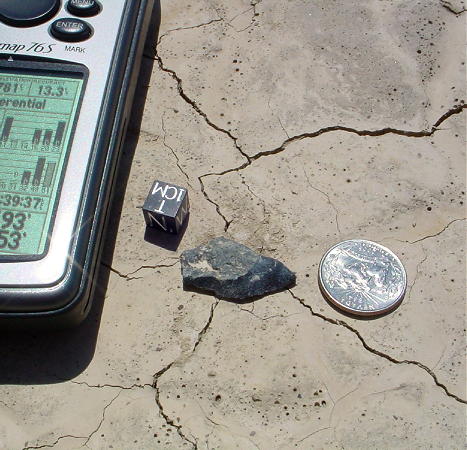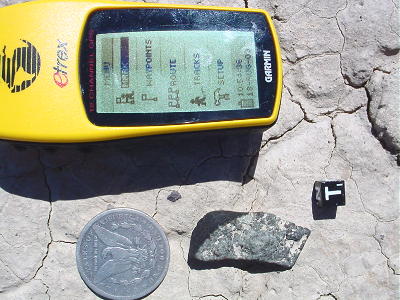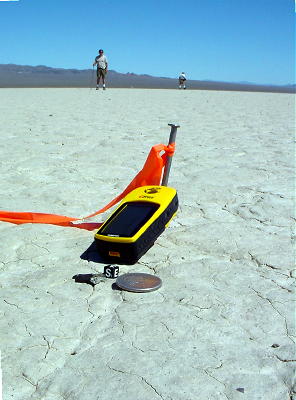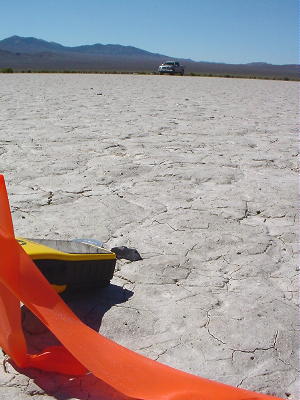An Article In Meteorite-Times Magazine
by Robert Verish
![]()
An Article In Meteorite-Times Magazine
by Robert Verish
Another Technique to Improve Meteorite-Recovery
Return to your old find locations after a couple of years have passed.
Whenever I can find the time, I like to "revisit" localities where I have spent a lot of time searching for meteorites, places such as dry lakes. I especially like to return to those spots where I have already made a find. I'm curious to see if the surface at that spot has changed in any way. I figure that if the spot I found a meteorite upon is a stranding surface, then logic would dictate that, given time, other meteorites will strand themselves on this same surface.
So, the question is, "How much time is needed for another meteorite to come along and get stranded on this same surface?" Will it take "geologic" time? Or, do these meteorites come and go through wave action with every high-stand of water?
It is interesting to see how much a dry lake changes between rainfalls. Over a relatively short period of time some surfaces on these intermittently wet playas go from being covered with a fluffy, uneven clay, to becoming a hard, flat and cracked surface. This is a process that some of us have nicknamed "resurfacing", and it has been a topic that we have been discussing a lot lately. Because it appears that this removing or moving about of this soft clay by wave action has resulted in the uncovering of meteorites that were once buried. Very likely that meteorites are intermittently buried and then exposed again over short periods of time, such as, when the "seasons" change (going from the monsoonal storms of summer to the days-long storms of winter).
So that, even on dry lakes that don't appear to be having any net change over the years, a stranding surface that was covered with clay on one visit may become uncovered (and could expose a meteorite) on a subsequent visit.

All of the images in this article are of the same dry lake, which is located in Central Nevada near Tonopah.
The dry lake that is depicted in these images is one of those playas that doesn't appear to undergo any noticeable changes to its lakebed surface (at least over the past six years). But there have been some minor alterations to the surface that, when you consider the small size of the meteorite fragments being found here, the removal of even a thin layer of sediment becomes a significant factor with regards to meteorite-recovery.
If you enlarge the first image at the top of this article, it is easier to see the variations in the patterns on the surface of the lakebed. You'll notice that there are portions where the polygonal-patterned dessication cracks are covered over with a thin layer of silt. Other than that, the surface is very flat and smooth.
In the next image, you can see a close-up of that same surface. The meteorite fragment is less than 1 centimeter high and it rests on a flat and smoothed-out lakebed with dessication-cracks that are narrow and sharp-edged, which (along with the sharp bubble imprints) are all indicators that this portion of the lakebed has been recently "resurfaced".
Now compare that surface to the one depicted in the next (last) three images (see below).
The last three images were taken 6 years ago at this same spot.
If you enlarge these images, you'll notice that the surface back then was not as flat and smooth. It is noticeably hummocky (uneven). The few small dessication-cracks that can be seen cut along shallow depressions. It is possible that "resurfacing" over the past few years could have filled-in these shallow depressions and, as a result, could have exhumed additional meteorite fragments during this process of leveling-off the lakebed.

The above image was taken by me 6 years ago and depicts a flat meteorite fragment shortly after it was found by James LaBarbera. Compare the outline of the missing top-piece with the outline of the find made by Monika Waiblinger depicted in the preceeding image that I took immediately after she made her find on May 15th, 2009!
Yes, they do "physically-pair".

The above image is another in-situ view of the first find by James LaBarbera. In this image James first find is in the foreground. James is in the middle-ground standing next to another (smaller) fragment and (like the May 2009 find by Monika Waiblinger) it too is physically-paird to his first mass. In the background stands James' father, Gerry LaBarbera. He is standing next to the spot where he found a fragment of another DIFFERENT meteorite. This "different" meteorite is actually paired to an H-chondrite that was previously found by Monika Waiblinger on an earlier trip.
To say that this area was "hammered hard" by myself and 9 other team members for the past 6 years, would be an understatement!
Yet, after diligently returning to this locality year after year, the missing fragment was finally recovered.

The above image is yet another 2003 in-situ view of the first fragment. I've included this shot because it depicts a coinsidence. From this view it shows my truck parked very close to where the 2009 find was to be eventually found. If you compare this to my 2009 image at the top of this article, you can clearly see the 2009 find in the foreground and about 100 meters away is my truck parked next to the monument for the initial fragment of the 2003 find.
I wonder if the reason we "missed" this fragment over all these years is because I might have driven over it and parked right on top of it!
In any case, the elementary lesson learned here is:
Return to your old find locations after a couple of years have passed, and take notice if the surface has changed for the better. This "resurfacing" of the find locality may result in a replenishment of meteorites to this stranding surface.
REFERENCES:
My other articles can be found *HERE*
For for more information, please contact me by email:
Bolide*Chaser
